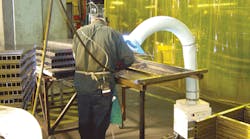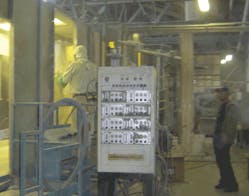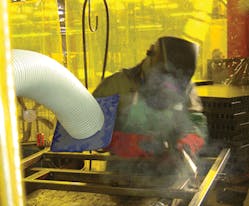Employees of a metal furniture manufacturer asked the National Institute for Occupational Safety and Health (NIOSH) to evaluate health hazards at their workplace. They were concerned about exposures to welding fumes and dust from powder painting and grinding operations. Some employees reported breathing problems, excessive tiredness and dust in their noses at the end of their work shifts.
The company had 146 employees and was located in a 110,000-square foot building. Employees' work included cutting, bending and welding sheet metal to form end tables, lockers and beds. Most employees spoke Spanish as their primary language, and most were members of a union. The company had a safety committee, which met every 3 months.
See Also: Environmental and Workplace Health Regulations & Standards
Employees bent metal furniture parts to the desired shapes and spot-welded the corners. Parts that could not be joined using a spot welder were welded by tacking the corners using a metal inert gas (MIG) welder. The total welding time per part was minimal.
MIG welders used welding wire that contained 1.4 percent to 1.8 percent manganese by weight. Some parts, such as bed frames, were made by cutting metal tubing with a saw and welding the pieces together. The welding area did not have its own ventilation system; however, one fume extractor was used while welding bed frames (Figure 1). Fourteen employees worked as MIG welders and 13 as spot welders.
After welding, employees in the grinding area used hand-held grinders to smooth the welds and remove sharp edges. Completed parts traveled on an overhead conveyor through a degreasing booth, where they were rinsed with phosphoric acid. As the parts exited the booth, an employee used a rag dipped in toluene for touch-up cleaning.
Metal parts were grounded with an electrostatic charge to attract paint particles to the part. The parts traveled on a conveyor through a powder paint spray booth in which permanently mounted spray guns coated the parts as they passed through. Painters stood at openings in the booth or sometimes stepped into the booth and manually powder painted any areas on the parts missed by the spray guns (Figure 2). Painted parts continued on the conveyor to a gas oven for curing, then to the packing and shipping departments. Painters regularly entered the spray booth and used a squeegee to remove paint overspray that had settled onto the floors and walls of the booth. The company had 15 painters.
What NIOSH Evaluated
During our site visit, we met with management and employee representatives and toured the facility. We observed the manufacturing processes, use of personal protective equipment (PPE) such as respirators and protective clothing and engineering controls (such as ventilation). We also interviewed 10 employees about their work.We took personal air samples to measure levels of air contaminants the employees might be breathing. For welders and grinders, we tested for metal fumes or particles and for carbon monoxide. We also tested welders for exposure to nitrogen dioxide. Spray painters' personal air samples were tested for 1,3,5-triglycidyl isocyanurate (TGIC), respirable dust and total dust. TGIC, a chemical in powder paint, can cause skin sensitization, allergic contact dermatitis and occupational asthma. Respirable dust is made of extremely fine particles that can be inhaled deeply into the lungs, and total dust is a measure of dust of all particle sizes.
We measured how much air was flowing into the spray paint booth through the door openings and how well welding fumes were being removed by the welding fume extractor. We also measured noise levels throughout the facility. We interviewed nine painters and gave them devices to check their breathing so we could see if their breathing was affected by TGIC in powder paint.
What NIOSH Found
Shortness of breath – Two of the employees we interviewed reported shortness of breath lasting a few minutes at a time. However, we concluded that these symptoms were not work-related. Two employees reported eye and throat irritation, and six employees reported no symptoms.
Fume exposure – We discovered that some of the MIG welders were exposed to manganese and carbon monoxide above recommended levels. Employees who welded tubing were exposed to higher concentrations of metal fumes than employees welding sheet metal. This most likely was because the metal tubing was thicker and required more time to weld. High manganese exposure has been associated with symptoms similar to Parkinson's disease, such as poor hand-eye coordination, slower movement, shaking, slower response speed, mood disturbance and memory loss. To reduce welding fume exposures, we recommended installing exhaust fans to blow welding fumes away from the welders and positioning the extraction hood closer to the welding fume to improve its ability to capture fume.
Work practices – Sometimes employees' welding practices increased their risk of exposure. For example, we observed a welder leaning over a bed frame to weld an opposite corner, placing his breathing zone over a previously welded area that still was smoking (Figure 3). If he had instead turned the rotary table that held the frame, that would have placed the recently welded corner at least 2 feet away from his breathing zone and reduced his exposure to welding fumes. We also observed that during welding on the inside of metal storage cabinets, welders sometimes positioned their heads inside the cabinets, increasing their exposure to welding fumes.
The high bay door and skylights in the building are opened during warm weather, providing additional fresh air and improved airflow. However, when doors and skylights are closed during cold weather, this extra ventilation is not available and welders could be exposed to more fumes.
Two employees sometimes welded on the same part without having a welding curtain between them. To prevent exposure to welding flash, it is important that welders do not remove their hoods if other welders nearby still are welding. Some welders were concerned that the welding curtains didn't provide enough eye protection, but when installed and used properly, colored, transparent curtains provide eye protection from harmful radiation exposure to the eyes. They also maximize the welder's visibility and allow people to see the welder in case of an accident or medical emergency. An orange curtain is ideal for filtering the ultraviolet and blue light generated by welding torches while maximizing visibility.
Burns – Welders reported being injured by sparks that burned through their flame-retardant cloth aprons and sleeves.
Dust exposure – Some painters were exposed to TGIC, respirable dust and total dust above recommended limits. Lab analysis of bulk samples of powder paint showed that it did not contain silica or asbestos, but the particles were small enough to be inhaled deeply into the lungs. We observed that spray painters had to step into the booth to touch up areas on parts that were missed by the mounted spray paint guns. This could increase their exposure to TGIC and dust. Repositioning the spray paint guns or using guns capable of moving back and forth or up and down might reduce the need for employees to do touch-up painting.
Compressed air – We also observed that employees at the powder paint booth used compressed air to clean excess powder paint dust off their clothing. This practice increases the amount of dust in the air, and also increases the risk of eye injuries from particles blown toward the face as well as skin injuries from compressed air injection. Using a vacuum would eliminate these hazards.
Ill-fitting respirators – Some employees wearing respirators had not been fit-tested and were not wearing their respirators properly. Painters did not wear protective clothing because the paint room was located 20 feet away from the curing oven and the painters felt it was too hot in the room to wear additional layers. Lowering air temperatures through air conditioning or other means would allow painters to safely and comfortably wear protective clothing.
Noise – Noise levels were above the recommended limits during grinding, welding and painting, and at the presses, which had the highest noise levels. Hearing protection was required in the press area, but some employees did not wear it or did not properly insert their earplugs. High noise levels occurred when metal hit metal, such as when parts were dropped into a metal bin or when metal struck against press surfaces while moving sheet metal parts. Using parts bins with thicker metal sides and having two employees move and carefully place sheet metal at presses could reduce noise.
Muscle strains – Muscle strains were common injuries. We observed that most stations, tables and carts for the press brake and machining system were not adjustable. In most cases the height was too low, requiring employees to maintain awkward postures to hold material in the machine. The company had specially designed jigs, some of which were at appropriate heights and let the welder move the furniture piece so he did not need to be in an awkward position when working on it, but some welders chose not to take advantage of this function. We observed some employees doing heavy lifting in awkward postures, increasing their risk for injuries such as strains, sprains and pulled or torn muscles. Employees also expressed concerns about material carts not rolling well, especially when full of material.
Cuts – Cuts also were common injuries. Employees wore cotton gloves that did not always prevent cuts when handling sheet metal. We also noted that improperly adjusted hand restraints allowed employees to place their hands in the pinch points of powered presses.
Reducing Worker Exposure
We recommended a number of actions to improve employee health and safety at this facility and similar facilities.
Welders should not position their heads in the plumes of welding fumes, and should keep their welding helmet visors down whenever nearby welders are welding. Employers should use welding rods and wire that contain a low percentage of manganese, and install exhaust fans in the welding area to remove fumes.
Painters should use powder paints that do not contain TGIC. If powder paints that contain TGIC are used, managers should teach painters about breathing and skin problems caused by TGIC. Painters should use a vacuum, instead of compressed air, to remove powder paint from clothes. Painters also should cover their hands and other exposed skin when painting, and wear powered air-purifying respirators with loose-fitting hoods.
The employer should install doors on the powder paint booth openings to help keep paint particles within the booth, and install exhaust fans in the paint room to remove hot air.
Suggestions for all employees and managers include:
- Respirators must be correctly fitted and worn properly. Managers should start a respiratory protection program that meets OSHA requirements.
- Employees should wear hearing protection properly. Managers should provide training on the use of hearing protection.
- Employees should avoid heavy lifting by using mechanical lifts or two-person lift teams whenever possible.
- Supervisors and employees should be trained to identify unsafe work practices and early warning signs of musculoskeletal disorders.
- Employees should report any work-related health problems to their managers.
- Provide prompt medical follow-up to employees who report respiratory symptoms.
- Employees should follow up any work-related health problems with their doctors.
(Note: Mention of company or product names does not imply endorsement by the National Institute for Occupational Safety and Health.)
Scott Brueck and Jessica Ramsey are NIOSH employees. Manuel Rodriguez and Dr. Ayodele Adebayo were NIOSH employees at the time of the evaluation. Questions about this evaluation may be directed to Brueck at [email protected], (513) 841-4140, or Ramsey at [email protected], (513) 841-4357.


